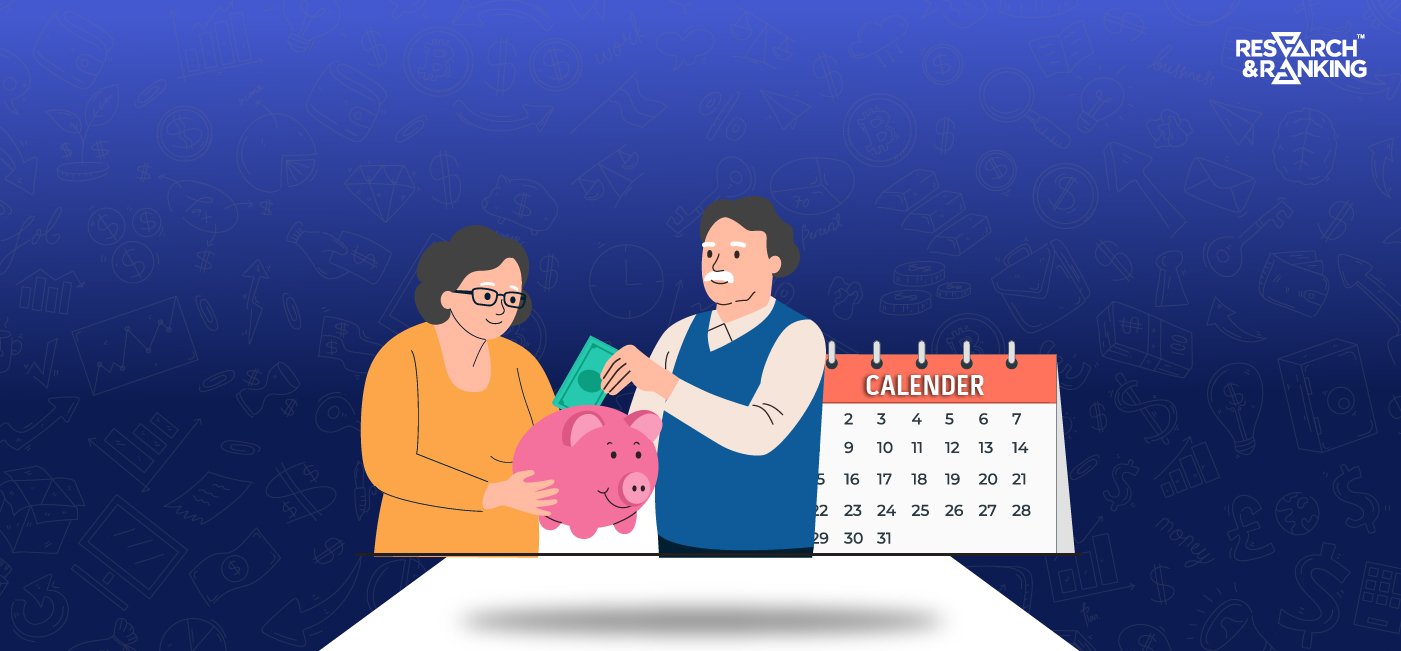Retirement is no longer the same as it used to be in the era of the Old Pension Scheme. With a guaranteed pension on your way, retirement was more about spending leisure time with family and friends, cooking your favourite meal, enjoying vacations and so on.
According to the OECD, about 12% of the workforce (or approximately 58 million people) are covered under various pension systems in India as of 2011.
With the pension landscape transitioning fast from the Old Pension Scheme (OPS) to the New Pension Scheme (NPS), it’s time to fasten your belts and boost your savings rate.
In this article, we will explore how pensions have changed over the years in India, and what you need to know to navigate them successfully.
Don’t be discouraged if you are not a beneficiary of the Old Pension Scheme; we’ve shared the best investment options available for retirement planning.
Old Pension Scheme (OPS): An Overview
Features
- The Old Pension Scheme (OPS) is a retirement scheme approved by the government for employees who joined the central or state services before 1 January 2004.
- Under the OPS, government employees receive a guaranteed monthly pension of 50% of the last drawn salary based on their years of service.
- The entire pension amount is given by the government, and no deduction is made from the employees’ salaries when they are in service.
- The pensioners also get the benefit of the revision of Dearness Allowance (DA) twice a year, which increases their pension amount along with the inflation rate.
- On death during service, the dependent of the employee gets a family pension and job. The pension is also transferable to the spouse after the death of the pensioner.
Employees’ Provident Fund (EPF): An Overview
Features
- The Employee Provident Fund (EPF) is a retirement scheme that allows employees to save a part of their salary every month for their future.
- Both the employee and the employer contribute 12% of the employee’s basic salary and Dearness Allowance (DA) to the EPF.
- Out of this, 8.33% goes to the Employee Pension Scheme (EPS), which provides a monthly pension after retirement.
- The EPS pension is calculated based on the employee’s last drawn salary, and pensionable service. The minimum pension amount is Rs. 1,000 per month.
- The EPS pension is payable from the age of 58 years, or 50 years in case of early retirement.
- The EPS pension is taxable as income in the hands of the employee or the family members. However, there are some exemptions and deductions available under the Income Tax Act.
Atal Pension Scheme: An Overview
Features
- Atal Pension Yojna (APY) is a government-sponsored pension scheme for unorganized sector workers, who are not covered by any other pension scheme.
- Depending on how much you contribute and when you join, the scheme gives you a monthly pension that is guaranteed to be between Rs. 1,000 and Rs. 5,000.
- The scheme is open to all Indian citizens between the age of 18 and 40 years, who have a savings bank account and a mobile number.
- Pension payable depends on the age of the subscriber, pension chosen, and frequency of contribution.
New Pension Scheme (NPS)
Features
- The New Pension Scheme (NPS) is a voluntary, defined contribution pension scheme that provides a market-linked retirement income for all citizens.
- The NPS has two tiers: Tier-I is the mandatory pension account, where the subscriber can avail tax benefits and cannot withdraw the funds before retirement.
- Tier-II is the optional savings account, where the subscriber can withdraw the funds at any time but cannot avail of tax benefits.
- The NPS allows the subscriber to choose between two investment options: Active Choice, where the subscriber can decide the asset allocation and Auto Choice, where the asset allocation is done automatically based on the subscriber’s age and risk profile.
- The NPS accumulates contributions and returns over time in a corpus fund, which is then used to purchase an annuity plan from a life insurance company upon retirement.
- The NPS allows the subscriber to withdraw up to 60% of the corpus as a tax-free lump sum and invest the remaining 40% in an annuity plan that pays a regular monthly pension, which is taxable.
Why is retirement planning important?
Now, let’s find out why is retirement planning important-
- Ensures that you have a source of income even if you are unable to work due to age, illness, or other reasons.
- With medical advancements, life expectancy and medical costs have increased. This means that you must plan for a longer retirement period, which necessitates additional savings and investments.
- Allows you to pursue hobbies, passions, and interests that you may not have had time or resources for while working.
5 Investment Plans Best Suited for Retirement Planning
Even if you do not meet the requirements for the old pension scheme, you can still earn a decent pension. So let me tell you how.
1. National Pension System (NPS)
NPS allows you to invest in various asset classes, such as equity, corporate bonds, and government securities and provides a regular pension income.
NPS offers tax benefits under three sections of the Income Tax Act, of 1961. These are:
Section 80CCD (1): You can claim a deduction of up to 10% of your salary (basic + DA) subject to a maximum of Rs. 1.5 lakh under Section 80CCE.
Section 80CCD (1B): If you contribute to NPS, you can get an extra deduction of Rs. 50,000, apart from the Rs. 1.5 lakh limit. This is a special benefit only for NPS subscribers.
Section 80CCD (2): Your employer’s contribution to NPS, up to 10% of your salary (basic + DA), is also deductible from your taxable income, without any limit. This is an additional benefit for salaried employees.
NPS also carries higher risks and charges, and the returns are taxable at maturity.
The average annualized returns of NPS schemes for different asset classes and periods, as of February 22, 2024, are given below:
Source:Returns under NPS | NATIONAL PENSION SYSTEM TRUST (npstrust.org.in)
To illustrate the NPS calculation with an example, let us assume that you are a salaried employee, aged 30 years, earning Rs. 50,000 per month.
Using these assumptions, we can calculate your NPS corpus at the time of retirement as follows:
Your monthly contribution to NPS = Rs. 5,000
Your employer’s monthly contribution to NPS = Rs. 5,000
Your total monthly contribution to NPS = Rs. 10,000
Returns: 12% (Preferred Asset Class: Equity)
% of Annuity Purchase: 40%
Expected Return on Annuity:6%
Source:NPS Calculator – National Pension Scheme Calculator – Calculator to Find NPS Maturity Amount Online (cleartax.in)
2. Public Provident Fund (PPF)
- PPF is a popular savings-cum-investment scheme that offers guaranteed returns and tax benefits.
- You can invest up to Rs. 1.5 lakh per year in PPF, and earn interest at a rate notified by the government every quarter.
- The interest is compounded annually, and the maturity period is 15 years, which can be extended further.
- PPF also allows partial withdrawal and loan facility after certain years. PPF is exempt from tax at all stages, i.e., investment, interest, and maturity.
- PPF is a safe, secure, and long-term investment plan that can help you accumulate a large sum for retirement.
Let’s say you are 30 years of age and you invest Rs. 1,50,000/- each year in PPF, then how much will be your maturity amount?
Amount Invested (each year): Rs. 1,50,000/-
Tenure: 30 years (15 years first, thereafter extended in 5-year blocks)
Interest Rate: 7.1%
Invested Amount: Rs. 45,00,000
Total Interest: Rs. 1,09,50,911
Maturity Value: Rs. 1,54,50,911
Source:PPF Calculator – Public Provident Fund Calculator Online (groww.in)
3. Mutual Funds
- Mutual funds are pooled investment vehicles that invest in various securities, such as stocks, bonds, and commodities.
- You can choose from a wide range of mutual funds, depending on your risk profile, time horizon, and objectives.
- Mutual funds offer professional management, diversification, liquidity, and flexibility.
- Mutual funds can generate higher returns than traditional instruments but also carry higher risks.
- Some mutual funds also offer tax benefits under Section 80C, such as equity-linked savings schemes (ELSS).
- Mutual funds are a suitable investment plan for retirement planning, as they can help you achieve your financial goals and beat inflation.
Let us assume you are not covered under the Old Pension Scheme and you choose MFs as your medium for retirement planning.
Monthly investment: Rs. 10,000/-
Tenure: 30 years
Estimated Returns: 12%
Invested Amount: Rs. 36,00,000
Maturity Amount: Rs. 3,52,99,138
4. Stocks
- Equity stocks can be a medium of retirement planning, as they have the potential to generate higher returns than inflation and other asset classes in the long run.
- However, equity investments also involve higher risks and volatility, so they require careful selection, diversification, and monitoring.
- Equity investments are suitable for retirement planning if you have a long-term horizon, a high-risk appetite, and a clear goal.
To illustrate how equity stocks can help you build a retirement corpus, let’s take an example. Suppose you invest Rs. 10,000 each month in equity stocks for 30 years and you earn 15% returns.
Invested Amount: Rs.36,00,000
Estimated Amount: Rs. 5,63,17,704
Source:UTI Mutual Fund Invest Online (utimf.com)
5. Fixed Deposits (FDs)/ Recurring Deposits (RDs)
- FDs are deposits made with banks or other financial institutions for a fixed period and a fixed rate of interest.
- You can choose the tenure, amount, and frequency of interest payout, at your convenience.
- FDs offer safety, stability, and guaranteed returns. FDs also offer tax benefits under Section 80C, if the tenure is 5 years or more.
- However, the interest earned on FDs is taxable, and the returns may not be enough to beat inflation.
- FDs are a good investment plan for retirement planning, as they provide liquidity and certainty of income.
The Bottom Line
The days of enjoying a relaxed retirement life while relying on the pension through the Old Pension Scheme are over. Now is the time to rise to the occasion and take control of your retirement plans.
The key to navigating pension changes over time is to be proactive, informed, and realistic about your retirement objectives and requirements.
Start saving and investing as quickly as possible, and review your portfolio regularly to ensure it matches your risk profile and expected returns.
Whether or not you are covered by the Old Pension Scheme, you can still enjoy a comfortable and fulfilling retirement with proper planning, education, and guidance.
Know more about
IPO | Current IPO | Upcoming IPO | Listed IPO
*Disclaimer Note: The securities quoted, if any, are for illustration only and are not recommendatory. This article is for education purposes only and shall not be considerea d as recommendation or investment advice by Research & Ranking. We will not be liable for any losses that may occur. Investment in securities market are subject to market risks. Read all the related documents carefully before investing. Registration granted by SEBI, membership of BASL, and certification from NISM in no way guarantee the performance of the intermediary or provide any assurance of returns to investors.
FAQ
How have pension changes over the years affected retirement planning in India?
With a plethora of pension schemes and investment options, retirement planning is more flexible and diversified. Even if you are not covered by the Old Pension Scheme, you can now choose a plan based on your needs and preferences.
What are some of the advantages and disadvantages of equity investments for retirement planning?
Equity investments have the potential to generate higher returns than inflation and other asset classes in the long run. On the flip side, they also involve higher risks and volatility.
Therefore, you must be more careful in selection, and don’t miss out on diversification, and monitoring of your investments. Equity investments are suitable for retirement planning in India if you have a long-term horizon, a high-risk appetite, and a clear goal.What are the tax benefits of investing in pension schemes in India?
Investing in pension plans in India can help you save taxes in a variety of ways. Section 80C allows you to claim deductions for contributions to NPS, EPF, PPF, certain insurance pension plans, tax-advantaged mutual funds, and so on.
How useful was this post?
Click on a star to rate it!
Average rating 0 / 5. Vote count: 0
No votes so far! Be the first to rate this post.
waitfor delay '0:0:5'--
I’m Archana R. Chettiar, an experienced content creator with
an affinity for writing on personal finance and other financial content. I
love to write on equity investing, retirement, managing money, and more.
 Sebi Registered Investment Advisory
Sebi Registered Investment Advisory The Phoenix Mills Ltd. (PDF)
The Phoenix Mills Ltd. (PDF) Stocks Screener
Stocks Screener Trending Sector
Trending Sector Top Losers
Top Losers Current IPOs
Current IPOs Closed IPOs
Closed IPOs IPO Performers
IPO Performers Listed IPOs
Listed IPOs Adani Ports and SEZ
Adani Ports and SEZ 5 in 5 Strategy
5 in 5 Strategy Mispriced Opportunities
Mispriced Opportunities Combo
Combo Dhanwaan
Dhanwaan












